





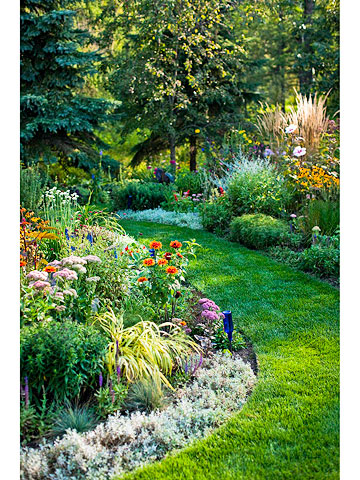
When she and her husband, David, moved to her country subdivision, Lark Kulikowski's original idea was to create a prairie-style garden by planting spring daisies, coneflowers, black-eyed Susans, yuccas, and several kinds of sedums among the existing field grass. "I thought the perennials would spread and that I'd like how it looked," she says. That was not the case. "I couldn't stand all that grass growing up around the perennials," she says.
Learn how to create your own step by step landscape plan.
That fall, responding to Lark's distress about the state of the garden experiment, David suggested they use herbicide to kill all the grass and start over in year two. So they did.
Over the winter, Lark began what was to become her habit in the off-season: She researched plants and gardening techniques to use in the coming year.
Like this garden? Click here to download a free garden plan!
continue reading belowIn Lark's second attempt, her garden took on its current configuration: three beds separated by paths. Lark brought in aged horse manure by the trailer load, spreading it over her sandy soil to help it hold moisture. As she planted, more manure was incorporated. Each year, she added more aged manure, switching to compost in later years.
In spring, Lark began dividing her existing perennials. She planted them in clumps of three, grouping one spring-blooming plant with one that flowers in summer and one that blooms in fall. She repeated each grouping multiple times throughout her garden.
She began a disciplined program of purchasing a few carefully selected perennials each year. "I tried not to get caught up with what was blooming and looked pretty when I went to the garden center," she says. Instead, she researched plants that bloom in each of her categories -- spring, summer, and fall -- purchasing a couple of each.
To fill in, Lark sowed seeds of annuals to provide color. "There was a lot of bare ground in the beginning," Lark says. "It took a lot of work to keep the weeds down."
That year, Lark began another habit she would continue: visiting public and private gardens for ideas. On her outings she noticed that many gardens didn't have much color from August to October. That became her goal for the following year.
Find public gardens near you for inspiration.
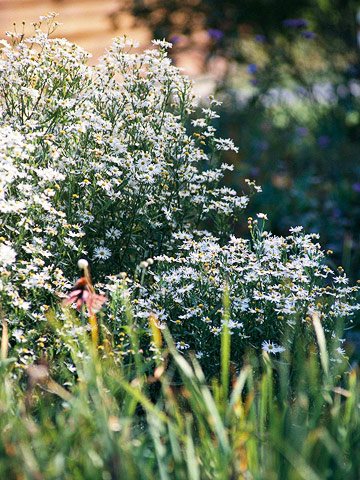
Over the winter, Lark identified several perennials that would add late-season color to her garden: Japanese anemones, asters, and Boltonia, particularly the cultivar 'Snowbank'.
In spring, she continued to divide existing perennials, adding her new late-season perennials to the groupings.
Learn more about Japanese anemone.
Learn more about asters.
Learn more about boltonia.
Discover more top fall flowers for sun and shade.
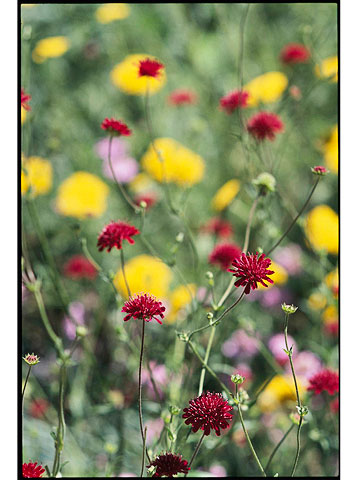
Lark began adding plants to extend her original three categories. She looked for plants that bloomed in early spring, late spring, early summer, late summer, early fall, and late fall.
"I kept it basic the first three years," she says. "Then I realized that after early May, I needed something that blooms from late May to early June." That's when she added plants like prairie smoke, meadow rue, and lupines. She also discovered that early-summer-blooming Knautia, rose campion, and larkspur (a self-seeding annual) would perform right through fall.
She also began to focus less on flower color, turning her attention to the color, texture, and form. The fine-textured, silvery-blue foliage of Russian sage, the chartreuse ruffled leaves of lady's mantle, and the vertical forms of ornamental grasses began finding their way into the border.
Learn more about meadow rue.
Learn more about lupines.
Learn more about knautia.
Learn more about rose campion.
Learn more about larkspur.
Learn more about Russian sage.
Learn more about lady's mantle.
Discover top ornamental grasses for your garden.
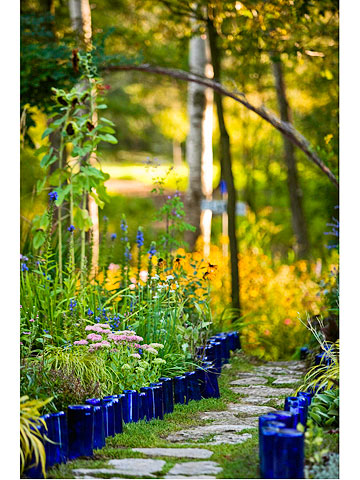
In year five, "the garden was really popping," Lark says. As it grew, so did Lark's confidence. "I was becoming more self-assured, and that's when I started gardening with my heart."
Always artistic, Lark began to experiment with using found objects to create art she could tuck in among the plants. A volunteer at the local recycling center, she was soon coming home with iron gears from tractors, rusty truck springs, and blue vodka bottles. A naturalized patch of blue forget-me-nots and daffodils in the woods inspired her to collect blue bowling balls from thrift shops to edge the path.
"I didn't want to use materials that everyone else uses -- like boulders or stumps. I wanted to use something that would make people smile," she says.
Always learning, Lark likes to find out what's successful for other gardeners and to share what's worked for her. Here are some of her tips:
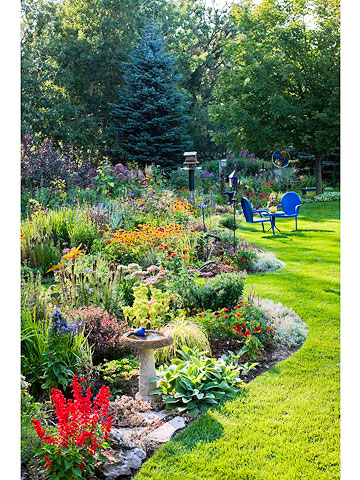
"I never thought I'd be so passionate about perennial gardening," Lark says in amazement. "Every year I learn a little more. Every year makes me happier and happier."
Copyright © www.100flowers.win Botanic Garden All Rights Reserved